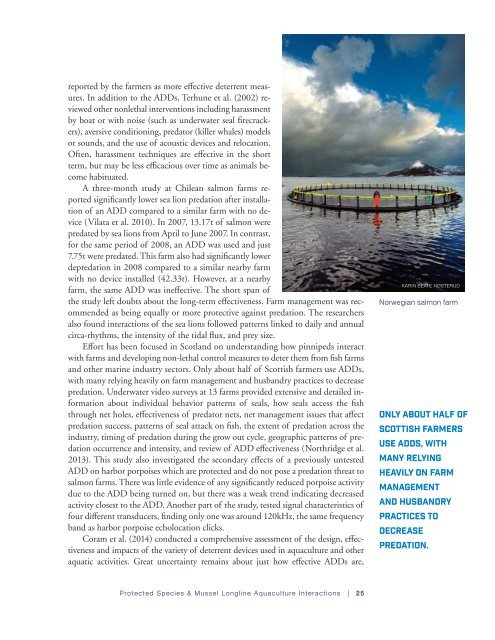Protected Species and Marine Aquaculture Interactions
x9Jh2
x9Jh2
Create successful ePaper yourself
Turn your PDF publications into a flip-book with our unique Google optimized e-Paper software.
eported by the farmers as more effective deterrent measures.<br />
In addition to the ADDs, Terhune et al. (2002) reviewed<br />
other nonlethal interventions including harassment<br />
by boat or with noise (such as underwater seal firecrackers),<br />
aversive conditioning, predator (killer whales) models<br />
or sounds, <strong>and</strong> the use of acoustic devices <strong>and</strong> relocation.<br />
Often, harassment techniques are effective in the short<br />
term, but may be less efficacious over time as animals become<br />
habituated.<br />
A three-month study at Chilean salmon farms reported<br />
significantly lower sea lion predation after installation<br />
of an ADD compared to a similar farm with no device<br />
(Vilata et al. 2010). In 2007, 13.17t of salmon were<br />
predated by sea lions from April to June 2007. In contrast,<br />
for the same period of 2008, an ADD was used <strong>and</strong> just<br />
7.75t were predated. This farm also had significantly lower<br />
depredation in 2008 compared to a similar nearby farm<br />
with no device installed (42.33t). However, at a nearby<br />
farm, the same ADD was ineffective. The short span of<br />
the study left doubts about the long-term effectiveness. Farm management was recommended<br />
as being equally or more protective against predation. The researchers<br />
also found interactions of the sea lions followed patterns linked to daily <strong>and</strong> annual<br />
circa-rhythms, the intensity of the tidal flux, <strong>and</strong> prey size.<br />
Effort has been focused in Scotl<strong>and</strong> on underst<strong>and</strong>ing how pinnipeds interact<br />
with farms <strong>and</strong> developing non-lethal control measures to deter them from fish farms<br />
<strong>and</strong> other marine industry sectors. Only about half of Scottish farmers use ADDs,<br />
with many relying heavily on farm management <strong>and</strong> husb<strong>and</strong>ry practices to decrease<br />
predation. Underwater video surveys at 13 farms provided extensive <strong>and</strong> detailed information<br />
about individual behavior patterns of seals, how seals access the fish<br />
through net holes, effectiveness of predator nets, net management issues that affect<br />
predation success, patterns of seal attack on fish, the extent of predation across the<br />
industry, timing of predation during the grow out cycle, geographic patterns of predation<br />
occurrence <strong>and</strong> intensity, <strong>and</strong> review of ADD effectiveness (Northridge et al.<br />
2013). This study also investigated the secondary effects of a previously untested<br />
ADD on harbor porpoises which are protected <strong>and</strong> do not pose a predation threat to<br />
salmon farms. There was little evidence of any significantly reduced porpoise activity<br />
due to the ADD being turned on, but there was a weak trend indicating decreased<br />
activity closest to the ADD. Another part of the study, tested signal characteristics of<br />
four different transducers, finding only one was around 120kHz, the same frequency<br />
b<strong>and</strong> as harbor porpoise echolocation clicks.<br />
Coram et al. (2014) conducted a comprehensive assessment of the design, effectiveness<br />
<strong>and</strong> impacts of the variety of deterrent devices used in aquaculture <strong>and</strong> other<br />
aquatic activities. Great uncertainty remains about just how effective ADDs are,<br />
kARIN BEATE NøSTERuD<br />
Norwegian salmon farm<br />
Only about half of<br />
Scottish farmers<br />
use ADDs, with<br />
many relying<br />
heavily on farm<br />
management<br />
<strong>and</strong> husb<strong>and</strong>ry<br />
practices to<br />
decrease<br />
predation.<br />
<strong>Protected</strong> <strong>Species</strong> & Mussel longline aquaculture interactions | 25


